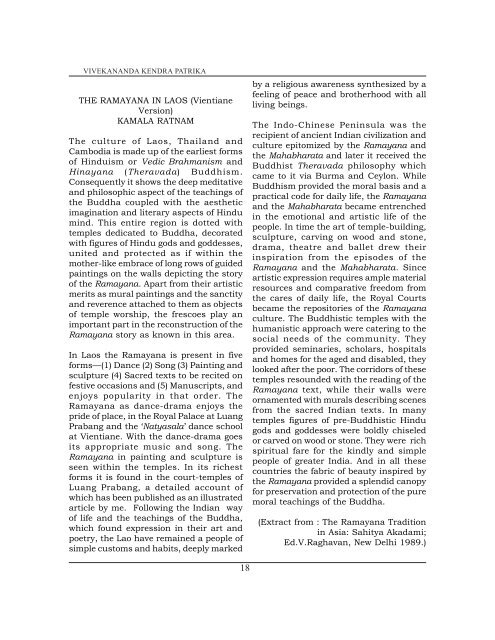Epics in Imprints-1.pdf - Vivekananda Kendra Prakashan
Epics in Imprints-1.pdf - Vivekananda Kendra Prakashan
Epics in Imprints-1.pdf - Vivekananda Kendra Prakashan
Create successful ePaper yourself
Turn your PDF publications into a flip-book with our unique Google optimized e-Paper software.
VIVEKANANDA KENDRA PATRIKA<br />
THE RAMAYANA IN LAOS (Vientiane<br />
Version)<br />
KAMALA RATNAM<br />
The culture of Laos, Thailand and<br />
Cambodia is made up of the earliest forms<br />
of H<strong>in</strong>duism or Vedic Brahmanism and<br />
H<strong>in</strong>ayana (Theravada) Buddhism.<br />
Consequently it shows the deep meditative<br />
and philosophic aspect of the teach<strong>in</strong>gs of<br />
the Buddha coupled with the aesthetic<br />
imag<strong>in</strong>ation and literary aspects of H<strong>in</strong>du<br />
m<strong>in</strong>d. This entire region is dotted with<br />
temples dedicated to Buddha, decorated<br />
with figures of H<strong>in</strong>du gods and goddesses,<br />
united and protected as if with<strong>in</strong> the<br />
mother-like embrace of long rows of guided<br />
pa<strong>in</strong>t<strong>in</strong>gs on the walls depict<strong>in</strong>g the story<br />
of the Ramayana. Apart from their artistic<br />
merits as mural pa<strong>in</strong>t<strong>in</strong>gs and the sanctity<br />
and reverence attached to them as objects<br />
of temple worship, the frescoes play an<br />
important part <strong>in</strong> the reconstruction of the<br />
Ramayana story as known <strong>in</strong> this area.<br />
In Laos the Ramayana is present <strong>in</strong> five<br />
forms—(1) Dance (2) Song (3) Pa<strong>in</strong>t<strong>in</strong>g and<br />
sculpture (4) Sacred texts to be recited on<br />
festive occasions and (5) Manuscripts, and<br />
enjoys popularity <strong>in</strong> that order. The<br />
Ramayana as dance-drama enjoys the<br />
pride of place, <strong>in</strong> the Royal Palace at Luang<br />
Prabang and the ‘Natyasala’ dance school<br />
at Vientiane. With the dance-drama goes<br />
its appropriate music and song. The<br />
Ramayana <strong>in</strong> pa<strong>in</strong>t<strong>in</strong>g and sculpture is<br />
seen with<strong>in</strong> the temples. In its richest<br />
forms it is found <strong>in</strong> the court-temples of<br />
Luang Prabang, a detailed account of<br />
which has been published as an illustrated<br />
article by me. Follow<strong>in</strong>g the Indian way<br />
of life and the teach<strong>in</strong>gs of the Buddha,<br />
which found expression <strong>in</strong> their art and<br />
poetry, the Lao have rema<strong>in</strong>ed a people of<br />
simple customs and habits, deeply marked<br />
18<br />
by a religious awareness synthesized by a<br />
feel<strong>in</strong>g of peace and brotherhood with all<br />
liv<strong>in</strong>g be<strong>in</strong>gs.<br />
The Indo-Ch<strong>in</strong>ese Pen<strong>in</strong>sula was the<br />
recipient of ancient Indian civilization and<br />
culture epitomized by the Ramayana and<br />
the Mahabharata and later it received the<br />
Buddhist Theravada philosophy which<br />
came to it via Burma and Ceylon. While<br />
Buddhism provided the moral basis and a<br />
practical code for daily life, the Ramayana<br />
and the Mahabharata became entrenched<br />
<strong>in</strong> the emotional and artistic life of the<br />
people. In time the art of temple-build<strong>in</strong>g,<br />
sculpture, carv<strong>in</strong>g on wood and stone,<br />
drama, theatre and ballet drew their<br />
<strong>in</strong>spiration from the episodes of the<br />
Ramayana and the Mahabharata. S<strong>in</strong>ce<br />
artistic expression requires ample material<br />
resources and comparative freedom from<br />
the cares of daily life, the Royal Courts<br />
became the repositories of the Ramayana<br />
culture. The Buddhistic temples with the<br />
humanistic approach were cater<strong>in</strong>g to the<br />
social needs of the community. They<br />
provided sem<strong>in</strong>aries, scholars, hospitals<br />
and homes for the aged and disabled, they<br />
looked after the poor. The corridors of these<br />
temples resounded with the read<strong>in</strong>g of the<br />
Ramayana text, while their walls were<br />
ornamented with murals describ<strong>in</strong>g scenes<br />
from the sacred Indian texts. In many<br />
temples figures of pre-Buddhistic H<strong>in</strong>du<br />
gods and goddesses were boldly chiseled<br />
or carved on wood or stone. They were rich<br />
spiritual fare for the k<strong>in</strong>dly and simple<br />
people of greater India. And <strong>in</strong> all these<br />
countries the fabric of beauty <strong>in</strong>spired by<br />
the Ramayana provided a splendid canopy<br />
for preservation and protection of the pure<br />
moral teach<strong>in</strong>gs of the Buddha.<br />
(Extract from : The Ramayana Tradition<br />
<strong>in</strong> Asia: Sahitya Akadami;<br />
Ed.V.Raghavan, New Delhi 1989.)

















